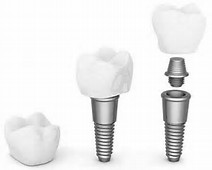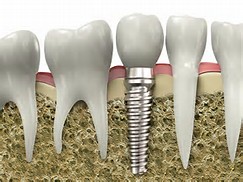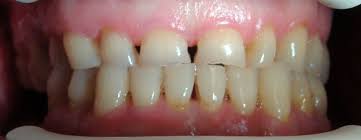During the last twenty years, dental implants have become the modern solution for restoring single tooth or all teeth. Due to its special features (the implantation procedure, time and way of finishing the prosthetic work, the price), dental implants are an alternative for conventional dental works. However, in some cases, such as over-resorbtion of the lower jaw, dental implants are the primary choice for… successful functional and aesthetic rehabilitation of the patient.

Today, there are a hudred different dental implants on the market, and most of them are made of titanium which proved a very good and successful material with no harmful effect on the body and with good results concerning bonding to the jaw bone. The appearance and design of different implants is quite similar – they are mainly in the shape of a screw or a root with carved surface.
An implant itself ia a part that imitates the root of a natural tooth and it is implanted in the jaw bone, after which an abutment imitating a cut-down tooth is attached the implant, and finally, a prosthetic work – dental crown is attached to the abutment. All kinds of fixed and removable prosthetic works (crowns, bridges, removable prostheses) can be attached to the implants.

Placing dental implants is a surgical procedure that is performed in a local anaesthesia. The procedure itself is painless, but after implanting, patients can experience temporary pain or swelling. After 4-6 weeks needed so that the implant can be ready to bear a dental bridge or a prosthesis, making the prosthetic work can start. There are certain cases of so called immediate implant load when the prosthetic work is attached to the implant immediately after implanting, which is very convinient for patients, but is possible only in special favourable cases.
Although dental implantology has advanced recently, placing implants is not always possible. There are diseases in which dental implantation is counerindicated: severe forms of diabetes, immune system disorders, hereditary or obtained blood dyscrasias, osteoporosis, malignacies etc. Besides, there are certain cases where the risk for the unsuccessful implantological therapy is significantly higher: taking bisphosphonates, bruxism (teeth grinding) and other parafunctions, experienced radiation therapy in the head area, over-consumption of alcohol and drugs, very poor oral hygine etc.
Today, the persantige of successfully obtained dental implantation therapy is very high – 95% of implants last l0 years and over 90 % last 15 years
Dental implants are a powerful therapeutic means but they are not almighty and one should keep in mind that they are substitutes for natural teeth after all.


